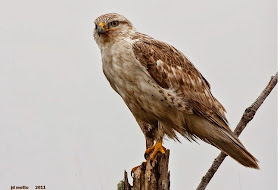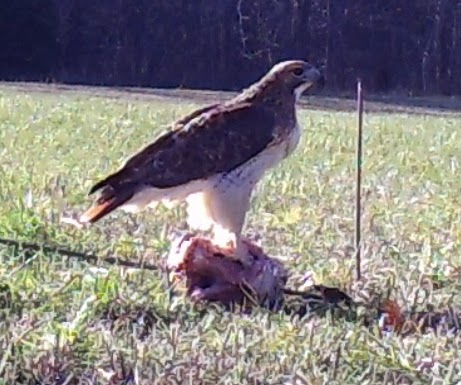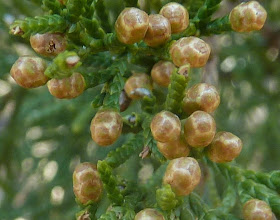 |
| Amelanistic Carolina wren- REK |
Barb saw this bird at our feeder, surrounded by hungry nuthatches, finches, juncos and all the other usual suspects, fighting for the only food after the sleet and snow hit. This little guy even tried to compete for suet with the red bellied and downy woodpecker.

At first we had only glimpses in the dull light of overcast skies. We sent a rather pitiful description to Charley Burwick- wren like tail, larger than a junco, blotchy white spots on the wings and a long, pointed and somewhat curved beak. Helpful as always, he suggested that it wasn't likely to be a hawk.
Thankfully it returned the following day when the sun came out, flitting around while I shot pictures through the sliding glass door. We sent pictures off to Charley who identified it as an amelanistic Carolina wren, also Barb's first species guess.
First a few terms in the confusing world animal pigmentation.
Leucism is a condition in animals characterized by reduced pigmentation. This may be an overall fading in color in the feathers. Unlike albinism, it is caused by a reduction in all types of skin pigment, not just melanin.
Amelanism is a pigmentation abnormality characterized by the lack of pigments called melanins, responsible for the coloration a albino animals. This sounds simple but the devil is in the details.
 |
| Carolina wren- normal coloration- Wikimedia |
All About Birds has several articles exploring the differences, including the variations in usage among experts. "Whether the result of partial albinism or leucism, the presence of
atypical white patches in normally darker plumaged birds gives rise to
the terms
pied or
piebald. ” The clearest explanation I found was this.
"True albinos in nature are rare, because without
protective pigments in the eyes, true albino birds quickly become blind.
Also, feathers wear out more quickly without pigments to provide
structural support. Albinism usually results from a genetic mutation
that interferes with production of the pigment melanin.
Partial albinos are much more common, and most
birders eventually see at least a few. Partial albinos have a pied
appearance with usually irregular patches of pure white feathers. After
an injury, regrowing feathers sometimes lack pigments. Some birds
develop stray white feathers as they age." birds.cornell.edu
Carolina wrens are little birds with big attitudes, bouncing around with an upraised tail, acting in charge of our deck. We have a wren house on a tree nearby which remains empty while wrens usually start building a nest in the garage even though they will then be trapped inside when we lock up for the night. Their perennial favorite housing is inside a curled up armadillo shell.
In the past most Carolina wrens wintered to the south but now we routinely see them in the winter. We haven't seen the piebald wren since the snow cleared. They are very territorial so I suspect that it was either passing through in migration or driven off by the normal colored wren now nesting in the armadillo shell on the deck shelf. Who says 'dillas are good for nothing?
 |
| Piebald junco- at the Watershed Center feeder- Charley Burwick |
Addendum:
I contacted Charley Burwick and his resident ornithologist Lisa Berger about the confusing nomenclature and learned that I am not alone. The partial amelanistic junco pictured above is a good example. I am including Lisa's cogent thoughts for my future reference. If you have had enough confusing science terminology, this would be a good place to stop.
=============================
Here is what Lisa writes.
"First a few terms in the confusing world animal pigmentation. Nomenclature applied to pigmentation observations, has been, well, gray, and otherwise non-specific with regard to origin. Proposed terms are listed first, followed by common or historic labels.
Total amelamism (Davis 2007) or Albinism, is the absence of all melanin from the plumage, eyes, and skin. In species that lack carotenoids, and more uncommon pigments, the genetic condition results in an all white plumage, pink eyes and skin (Davis 2007). Carotenoid pigments from diet, if present, result in retained red bill, crest, wings, and tail in Cardinal, or retained yellow in Evening Grosbeaks (Hudson 1997, Davis 2007).
Hypomelanism (Davis 2007) or leucism (Harrison 1964) is the abnormal reduction of melanin concentration in plumage, skin, eyes, or all of three areas, resulting in a faded appearance (Davis, 2007). Carotenoid and other non-melanistic pigments, if present, are unaffected.
Partial amelanism (Davis 2007) or partial albinism (Coues 1868) (partial albino is oxymoronic: Kind of like saying a woman is partially pregnant) is the abnormal absence of all melanin from parts of the plumage, skin, eyes or all three, and is the most frequently observed color abnormality in birds (Davis 2007). It may be expressed as a single white spot, one feather, or completely white plumage, although some melanin usually remains in the eye (van Grouw 2006). Origins are hereditary, environmental (malnutrition, toxins, injury, disease, parasites, shock, old age). Hormones also play a role (Keck 1933, Davis 2007).
All About Birds (birds.cornell.edu) has several articles exploring the differences, including the variations in usage among experts. "Whether the result of partial albinism or leucism, the presence of atypical white patches in normally darker plumaged birds gives rise to the terms pied or piebald. ” The clearest explanation I found was this. "True albinos in nature are rare, because without protective pigments in the eyes, true albino birds quickly become blind. Also, feathers wear out more quickly without pigments to provide structural support. Albinism usually results from a genetic mutation that interferes with production of the pigment melanin.
Partial albinos are much more common, and most birders eventually see at least a few. Partial albinos have a pied appearance with usually irregular patches of pure white feathers. After an injury, regrowing feathers sometimes lack pigments. Some birds develop stray white feathers as they age."





 One final annual April event; the black vultures are brooding in our old barn. After four years of observing them, they look bored when I open the door to the stall. Today I waited at the open door for several minutes before she stood up to show me the eggs.
One final annual April event; the black vultures are brooding in our old barn. After four years of observing them, they look bored when I open the door to the stall. Today I waited at the open door for several minutes before she stood up to show me the eggs.























